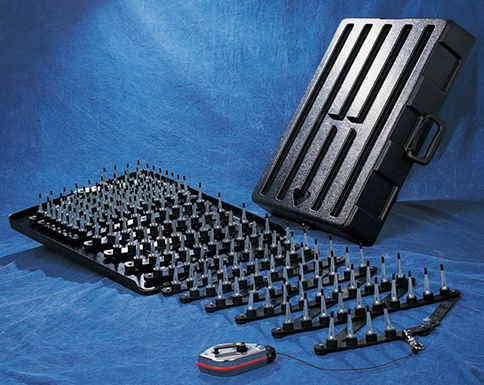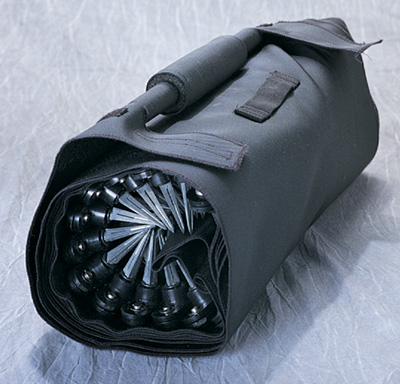
Popping a Hole in High-Speed Pursuits
Originating Technology/NASA Contribution
NASA’s Plum Brook Station, a 6,400-acre, remote test installation site for Glenn Research Center, houses unique, world-class test facilities, including the world’s largest space environment simulation chamber and the world’s only laboratory capable of full-scale rocket engine firings and launch vehicle system level tests at high-altitude conditions. Plum Brook Station performs complex and innovative ground tests for the U.S. Government (civilian and military), the international aerospace community, as well as the private sector.
Recently, Plum Brook Station’s test facilities and NASA’s engineering experience were combined to improve a family of tire deflating devices (TDDs) that helps law enforcement agents safely, simply, and successfully stop fleeing vehicles in high-speed pursuits.
Partnership
Phoenix International, Ltd., of Brookfield, Wisconsin, has been manufacturing and marketing the MagnumSpike! spike-lined TDDs to law enforcement since 1986. Up until the company’s involvement with Plum Brook Station, spikes were inadvertently being knocked onto the roadways whenever tires from fleeing cars and trucks were deflated by the device. This was caused by the enormous impact created when vehicles are brought to a halt. Cleaning up these spikes from out of the roadway was problematic for officers.
Phoenix International needed a mechanism to keep the spikes in place until they are ready for release. The small, woman-owned company learned about NASA’s Garrett Morgan Commercialization Initiative, a program operated by Glenn that allows minority companies to grow and strengthen their businesses by leveraging NASA technology, expertise, and programs. Realizing the valuable assistance it could provide in improving the MagnumSpike!, the Garrett Morgan Commercialization Initiative paired Phoenix International with Glenn engineer Chip Redding.
Redding evaluated the MagnumSpike! in order to understand and control the variables preventing repeatable, reliable performance. His analysis was then transferred to a Cleveland-based engineering firm that conducted additional tests for precise measurements of the retention system used to lock in the spikes. Based on the analyses, both Redding and the engineering firm provided Phoenix International’s engineers with recommendations on alterations to the mechanism that can provide a precise, friction-free release of the spikes.
Additionally, the MagnumSpike! was tested at Plum Brook Station, where researchers concluded that its retention clip could not reliably hold all of the device’s spikes in place. As a direct result of this assistance, Phoenix International decided to develop a pin shear method to incorporate into its line of MagnumSpike! TDDs. Glenn and the Garrett Morgan Commercialization Initiative granted Phoenix International a financial award, through a Simplified Technology Transfer Agreement, to assist with completion of the design, testing, and manufacturing of new, friction-free retain-release clips that were generated from the new pin shear method.
The financial award was also used for product marketing and promotion of the device, in addition to further development and initial manufacturing of a new vehicle stopping product called the StaticStop, which consists of a disposable spiked wheel chuck that can be used to detain vehicles in routine traffic stops.
“R&D is the lifeblood of what we do,” noted Toranj Marphetia, Phoenix International’s president and chief executive officer. “The Garrett Morgan Commercialization Initiative provided us with much-needed expertise to evaluate and measure our new [MagnumSpike!] mechanism,” she added.
Product Outcome
The new, improved MagnumSpike! has been field tested and “pursuit proven” as the ultimate weapon against high-speed chases. It swiftly and safely stops everything from 18-wheelers to compact vehicles, even vehicles equipped with new self-sealing and run-flat tires. (According to tests conducted by the National Institute of Justice—the research, development, and evaluation agency of the U.S. Department of Justice, the MagnumSpike! is the only TDD on the market to consistently stop vehicles outfitted with these new types of tires.) Decreasing chase time for police forces increases officer safety, saves lives, and prevents property damage.
“We have used the MagnumSpike! at least 30 times with complete success in ending the pursuit without injuries or cars getting damaged,” said Gary Miller, sheriff of Wright County, Minnesota. “From our testing and experience, I can say the MagnumSpike! is the best. It does the job every time, regardless of vehicle size,” he added.
Available several sizes and models, the Magnum Spike! can have up to 250, 2.5-inch, precision-cast, rust-proof spikes, able to withstand multiple high-speed impacts. Each spike contains three sharp corners. Additionally, a patented choke-proof design prevents them from getting stuck in the deflated tires.
The technology, which also has application in U.S. Department of Defense and U.S. Department of Homeland Security operations, is currently flaunting an impressive 100-percent safety record and 100-percent take-down record in deflating all tires that have come across its path. In one unique instance, the MagnumSpike! made an impact—without making impact. When a fleeing suspect saw the strip of spikes, he skidded his vehicle to a stop, got out, and surrendered.
Phoenix International anticipates that the improved MagnumSpike! will widen its market five-fold, leading to a major increase in sales—or, a major “spike” in business.
MagnumSpike!™ is a trademark of Phoenix International, Ltd.

The MagnumSpike! tire deflation device is designed to safely, swiftly, and consistently end high-speed pursuits within a predictable short distance. It gives law enforcement officers control over extremely dangerous situations, preventing property damage and safeguarding not only their lives, but the lives of innocent bystanders and the occupants of the pursued vehicles.

The “wrap and roll” MagnumSpike! model, packed in a soft ballistic nylon case, is 12 feet in length, weighs 9 pounds, and contains 160 spikes.

One of hundreds of trucks stopped by MagnumSpike!













